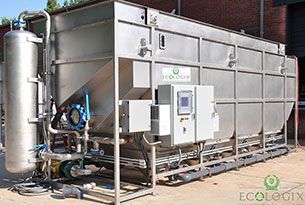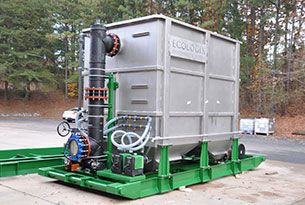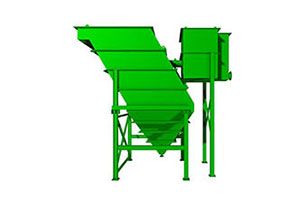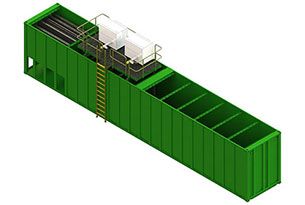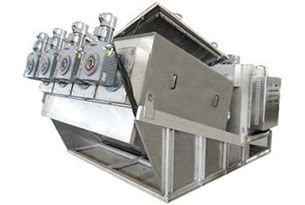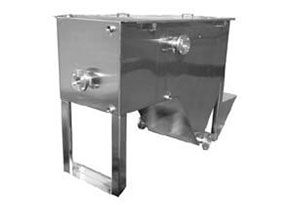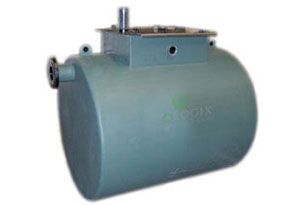Summary
Direct lithium extraction (DLE) represents a sophisticated chemical engineering paradigm for isolating lithium ions from aqueous brines, leveraging selective separation mechanisms to achieve high-purity yields. This article delineates the intricate process flow, encompassing pretreatment, extraction, purification, and wastewater management stages. Through mathematical modeling and chemical analyses, it explains the underlying thermodynamics and kinetics, while integrating practical applications of equipment. This article aims to provide a comprehensive understanding of how modular water treatment systems facilitate scalable DLE implementations, addressing impurity removal and resource recovery with precision.
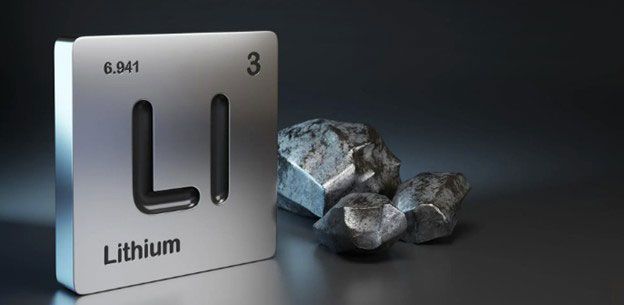
Table of Contents
Introduction
In the realm of extractive metallurgy and hydrometallurgy, Direct Lithium Extraction (DLE) is a key technology for procuring lithium chloride () or lithium hydroxide () from saline brines, bypassing the protracted evaporation cycles of conventional methods. The selectivity of DLE sorbents is grounded in principles of coordination chemistry and electrostatic interactions.
This selectivity is crucial because the small ion has a high hydration energy (-515 kJ/mol) compared to competing cations like (-406 kJ/mol) [1]. DLE sorbents are engineered to leverage this difference, creating a selective site that facilitates the differential binding of over larger, less tightly bound ions.
The process flow is engineered to exploit these selective affinities amidst a matrix of competing cations such as sodium , potassium , magnesium , and calcium . The imperative for DLE stems from the escalating demand for lithium in Energy Storage Systems (ESS), necessitating efficient extraction from low-concentration sources like geothermal brines (typically 50 - 500 mg/LLi) and oilfield produced waters. The DLE process integrates unit operations that minimize water consumption and often maximize recovery rates, frequently exceeding 90%. Central to this efficiency is the pretreatment phase, where equipment such as oil-water separators and chemical reaction tanks ensures brine purity prior to extraction, mitigating fouling and enhancing downstream performance.
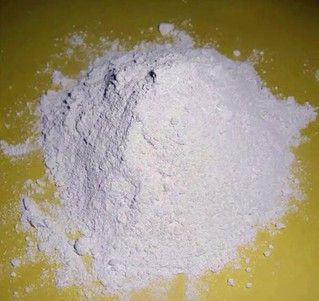
Process Overview
The DLE process flow is a sequential cascade of unit operations: brine extraction, pretreatment, lithium capture, elution, purification, and reinjection or wastewater treatment. Brine is pumped from subsurface aquifers, with flow rates governed by Darcy's law:
with as volumetric flow rate (m/s), as hydraulic conductivity (), as cross-sectional area (), and as the dimensionless hydraulic gradient (ratio of change in hydraulic head to distance) [2].
Pretreatment removes suspended solids and natural organic matters (NOMs), followed by the core extraction step using adsorption, ion exchange, solvent extraction, or membrane processes.
In adsorption-based DLE (A-DLE), lithium-selective sorbents like lithium manganese oxides (LMO) or lithium titanium oxides (LTO) capture via surface complexation. The loaded sorbent is eluted with dilute acid, yielding a lithium-rich eluate. Ion exchange employs resins that swap for or , while solvent extraction utilizes organic extractants like tri-n-butyl phosphate (TBP) in kerosene to partition into an organic phase. Membrane processes, such as nanofiltration (NF) or electrodialysis (ED), exploit Donnan exclusion, where the rejection coefficient is:
with and denoting permeate and feed concentrations, respectively [3].
Post-extraction, the eluate undergoes precipitation or electrowinning to form battery-grade products like or , with depleted brine reinjected to maintain aquifer balance. Crucially, while the majority of , , , and ions are typically reinjected, the DLE process removes key foulants like silica and hydrocarbons, which are then concentrated into a sludge for disposal or dewatering using equipment such as multi-plate screw presses. The overall mass balance for lithium recovery is expressed as:
with as efficiency, typically 80-95% in optimized systems.
Table 1: Comparison of DLE Technologies
| Aspect | Adsorption | Ion Exchange |
|---|---|---|
| Selectivity Mechanism | Surface binding via chemisorption | Ion swapping with functional groups |
| Typical Recovery Rate | 85-95% | 80-90% |
| Energy Consumption | Low (0.5-2 kWh/kg Li) | Moderate (1-3 kWh/kg Li) |
| Chemical Inputs | Acid for elution (e.g., HCl) | Regenerants (e.g., NaCl) |
| Scalability | High, modular beds | High, column operations |
| Impurity Rejection | Excellent for Mg²⁺/Ca²⁺ | Good, but prone to fouling |
Technical Details
Adsorption Isotherms and Kinetics
The chemical underpinnings of DLE are rooted in adsorption isotherms.
The Langmuir model for on LMO sorbents is:
This equation defines variables as follows: is equilibrium adsorption capacity (mg/g), is maximum capacity (e.g., 30 mg/g), is Langmuir constant (), and is equilibrium concentration () [4].
Kinetics follow pseudo-second-order:
with () typically 0.01-0.1 for LMO.
To illustrate, consider a scenario where experimental testing shows the equilibrium concentration in the liquid brine is 20 mg/L post-adsorption, with:
compute:
This value indicates efficient sorbent loading under these specific equilibrium conditions.
Solvent Extraction
In solvent extraction, the distribution coefficient is pH-dependent, optimized at pH 10-12 for β-diketone extractants.
The reaction is:
with equilibrium constant
Optimization uses Newton-Raphson:
where
Example: For
initial pH = 10, iterative convergence yields optimal pH [3].
Membrane-Based DLE
For membrane-based DLE, flux is modeled as:
with permeability P (m/s), concentration gradient ΔC (mol/m³), osmotic pressure Δπ (Pa), gas constant R (8.314 J/mol·K), and temperature T (K).
Example calculation: For a lithium concentration of 200 mg/L (0.029 mol/L), the following parameters are used:
- Permeability:
- Osmotic Pressure:
- Temperature:
These yield a flux:
For an annual production of 10,000 tpa Li (1.44 x 10⁶ mol/yr), the required membrane area is:
Pretreatment Equipment Integration
Using a dissolved air flotation (DAF) system will remove oils and solids efficiently:
where ( k ) is rate constant (min⁻¹) and t is residence time (10-30 min). Lamella clarifiers boost settling velocity:
Per Stokes' law, with gravitational acceleration , particle density , fluid density , particle diameter , and viscosity [5]. Example: For silica particles with:
the settling velocity is:
.
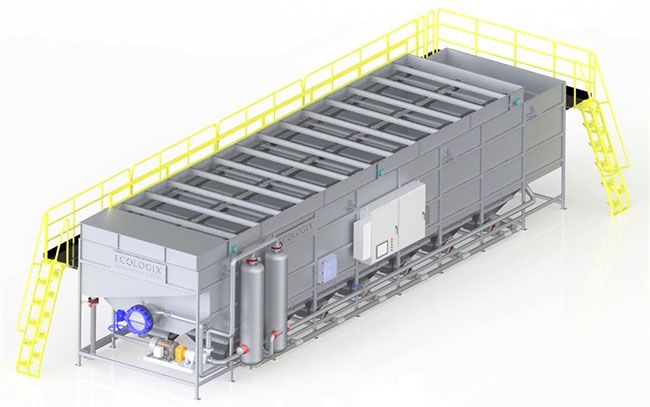
Case Studies
Case Study 1: Salton Sea Geothermal Brine Project
Electrochemical DLE achieves 95% recovery, with pretreatment via DAF technology removing silica (SiO₂) through flocculation: Si(OH)₄ + Al³⁺ → Al₂SiO₅ + H⁺. Process flow: Brine at 200°C is cooled, pretreated, then Li⁺ extracted via redox intercalation: LiFePO₄ ⇌ FePO₄ + Li⁺ + e⁻, with Faraday efficiency >90% [6]. Yield: 100 m³ brine at 400 mg/L Li produces 38 kg LiCl.
Case Study 2: Smackover Formation Oilfield Brine
Adsorption DLE yields 85% Li, with wastewater treated using multi-plate screw press for sludge dewatering (30% dryness). Mathematical yield: From 100 m³ brine at 300 mg/L Li, extract 25.5 kg LiCl post-purification [7]. Pretreatment employs DAF for oil removal, achieving >95% efficiency.
Table 2: Comparison of Case Studies
| Parameter | Salton Sea | Smackover |
|---|---|---|
| Brine Type | Geothermal (high T, Si) | Oilfield (high TDS, hydrocarbons) |
| Extraction Method | Electrochemical | Adsorption |
| Recovery Efficiency | 95% | 85% |
| Pretreatment Needs | Silica removal via clarification | Oil separation via DAF |
| Energy Input | 2.5 kWh/kg Li | 1.8 kWh/kg Li |
| Wastewater Volume | Low (recycled) | Moderate (dewatered) |
Challenges
DLE faces thermodynamic barriers in selectivity, with Gibbs free energy:
for distribution coefficients for over , necessitating multi-stage cascades [8]. Energy demands escalate in low-Li brines (), where concentration factors exceed 100x, per Raoult's law deviations. Fouling from borates (B(OH)4-) and scaling from () reduce flux by 20-50% over cycles.
Solutions
Companies like Ecologix Environmental Systems provide modular solutions to address these challenges. Oil-water separators achieve >95% hydrocarbon removal via coalescence, particularly effective for fouling in hydrocarbon-rich brines. Chemical reaction tanks enable pH control for precipitation: Mg²⁺ + 2OH⁻ → Mg(OH)₂ ↓, Ksp = 10-11.15, removing 99% Mg at pH 10.5. For fouling from light, emulsified contaminants like borates or oils, dissolved air flotation (DAF) enhances removal via bubble attachment with efficiency:
where k is the rate constant (min⁻¹) and t is residence time (10-30 min); alternatively, for scaling from heavier precipitates like CaSO₄, lamella clarifiers are preferable, enhancing floc formation kinetics:
where is particle number, collision efficiency, velocity gradient (). Moving bed biofilm reactors (MBBR) treat organics via Monod kinetics ensuring closed-loop wastewater management [5].
Material Selection
Selecting appropriate materials of construction (MOC) is critical for the longevity and efficiency of DLE systems, particularly in the harsh environment of high-salinity brines. Brines in DLE applications often contain elevated levels of chloride ions (Cl⁻), which can exceed 100,000 mg/L in unconventional sources like geothermal or oilfield waters, leading to severe corrosion of metals and alloys [2, 11]. Additionally, the process frequently involves pH adjustments (e.g., to 10.5 for Mg²⁺ removal) and aggressive chemicals like hydrochloric acid (HCl) for desorption in ion-exchange setups, exacerbating material degradation through pitting, crevice corrosion, and stress corrosion cracking [3, 10]. Temperature fluctuations (up to 80°C in some adsorption processes) and exposure to impurities like sulfate (SO₄²⁻) or borates further compound these challenges, potentially increasing maintenance costs and downtime [2, 5]. For environmental engineers, choosing MOC is not only about operational reliability but also about minimizing leaks or failures that could contaminate aquifers or wastewater streams, aligning with sustainable design principles.
Recommended Materials for DLE Equipment
Based on industry practices and DLE process requirements, the following materials are well-suited for DLE components like pipes, tanks, columns, and membranes due to their resistance to chloride-induced corrosion and chemical attack:
- Duplex Stainless Steels (e.g., 2205 or 2507 Super Duplex): These alloys offer excellent resistance to pitting and crevice corrosion in high-chloride environments and are cost-effective for structural components like piping and vessels. They perform well at pH 1-11 and temperatures up to 300°C, making them ideal for brine handling and acid desorption stages [12].
- Hastelloy C-276 (Ni-Mo-Cr Alloy): For highly corrosive areas like acid elution columns or high-HCl stripping units, this nickel-based superalloy provides superior resistance to chloride pitting and acid attack, even at pH <1. It's commonly used in DLE for ion-exchange resins, though higher cost limits it to critical components [3, 10].
- Titanium (Grade 2 or 5): Titanium's passive oxide layer provides outstanding corrosion resistance in chloride brines and acidic conditions (pH 1-13). It's ideal for heat exchangers, pumps, and membrane housings in geothermal brines, where high temperatures are common, but its cost makes it selective for high-value areas [2, 6].
- High-Density Polyethylene (HDPE) or Polypropylene (PP): For non-structural parts like tanks, liners, and pipes in low-pressure setups, these plastics are corrosion-resistant to chlorides, acids, and pH swings (0-14). They're cost-effective and suitable for wastewater reinjection lines or low-corrosion zones [5, 9].
These materials mitigate the risks of high chloride concentrations and pH extremes, as evidenced by DLE pilot tests [10, 11].
Materials to Avoid in DLE
Certain materials are unsuitable due to rapid degradation in DLE environments, leading to leaks or high OPEX. Avoid:
- Carbon Steel or Mild Steel: Highly susceptible to chloride pitting and uniform corrosion, especially at pH <4 or >10, leading to rapid failure in pipes or tanks [2, 11].
- Standard 304/316 Stainless Steel: Prone to pitting in high-chloride brines and acidic desorption (pH <2); use only for non-contact areas [3, 11].
- Aluminum Alloys: Corrode quickly in alkaline brines (pH >9) or with sulfate impurities; unsuitable for adsorption or membrane housings [2, 6].
- Copper Alloys: Severe dezincification and pitting in chloride-rich brines; avoid for valves or heat exchangers [5, 9].
These materials can lead to environmental risks like brine leaks, with studies showing carbon steel failing in <6 months in high-Cl⁻ DLE setups [6, 10]. Instead, opt for the recommended MOC to ensure system longevity and safety.
Conclusion
Direct lithium extraction (DLE) enables efficient lithium recovery from low-concentration brines, achieving recovery rates of 80-95% through a process flow that includes extraction, pretreatment, capture, and wastewater management. Thermodynamic and kinetic models, such as those for adsorption isotherms and Gibbs free energy, optimize selectivity despite challenges from high-chloride brines (up to 200,000 mg/L Cl⁻) and pH ranges of 1-12. Equipment like dissolved air flotation (DAF) and lamella clarifiers, combined with corrosion-resistant materials such as duplex stainless steels and titanium, removes impurities and extends system durability, reducing risks of environmental contamination [2, 10, 11]. Closed-loop brine reinjection minimizes water consumption, supporting sustainable practices while meeting lithium demand for energy storage systems (ESS). Advances in sorbent durability, membrane selectivity, and low-carbon processes, as demonstrated by the Zero Carbon Lithium™ project, will further improve DLE's efficiency and environmental performance [10]. DLE provides a practical approach to critical mineral production, balancing economic and ecological priorities.
Have a project you would like to discuss?
Contact Ecologix Environmental Systems today to learn more about our engineered solutions.
Contact UsGlossary
- A-DLE: Adsorption-type Direct Lithium Extraction - A method within DLE that employs lithium-selective sorbents to bind and extract lithium ions from brine [10].
- Adsorption: Surface binding process where atoms, ions, or molecules from a gas, liquid, or dissolved solid adhere to a solid surface, forming a thin film; in DLE, it involves lithium ions attaching to selective sorbents [11].
- BOD: Biochemical Oxygen Demand - The amount of dissolved oxygen required by aerobic microorganisms to decompose organic matter in a water sample at a specific temperature over a defined period, serving as an indicator of organic pollution in wastewater [9].
- Brine: High-salinity solution of salt in water, occurring naturally underground, in salt lakes, or as seawater; in DLE contexts, it specifically refers to lithium-bearing saline solutions sourced from geothermal or oilfield reservoirs [11].
- Ca²⁺: Calcium Ion - A divalent cation commonly found in brines that can form insoluble compounds like calcium sulfate or carbonate, potentially contributing to scaling in pipelines and equipment under certain conditions [11].
- CAPEX: Capital Expenditures - The funds allocated for acquiring, upgrading, or maintaining long-term physical assets such as equipment, facilities, and infrastructure in DLE projects, distinct from ongoing operational costs [11].
- Carbonation Processes: CO2-based lithium precipitation methods - Techniques in DLE that utilize carbon dioxide to precipitate lithium carbonate from lithium-rich solutions, including direct, indirect, reverse, and electrochemical variants for efficient recovery [11].
- CDI: Capacitive Deionization - An electrosorption process that removes ions from water by applying an electric potential to porous electrodes, enabling low-energy lithium recovery from dilute solutions [11].
- Chemisorption: Chemical bonding in adsorption - A type of adsorption where atoms or molecules form chemical bonds with the surface of a solid, often involving electron transfer; in DLE, it facilitates strong, selective binding of lithium to sorbents [11].
- Closed-Loop System: Water recycling configuration - A system design in DLE that recirculates water and brine to minimize consumption and waste, enhancing sustainability by reinjecting depleted brine into aquifers [11].
- Coalescence: Droplet merging in oil-water separation - The process where small oil droplets combine into larger ones, facilitating gravity-based separation in oil-water separators to achieve high removal efficiency [5].
- Coordination Chemistry: Metal-ligand interactions for selectivity - The study of compounds formed between metal ions and ligands, which underpins the selective binding of lithium ions to extractants or sorbents in DLE processes [1].
- CRI: Commercial Readiness Index - A metric that evaluates the market viability and deployment potential of technologies like DLE, assessing stages from pilot to full commercial operation [11].
- Critical Mineral: Essential material like lithium - Non-fuel minerals vital to economic and national security, with supply chains vulnerable to disruption; lithium is designated as such due to its role in energy technologies [9].
- D: Distribution Coefficient - The ratio of the concentration of a solute (e.g., lithium) in the organic phase to that in the aqueous phase during solvent extraction, a pH-dependent metric used to optimize lithium separation [3].
- DAF: Dissolved Air Flotation - A water treatment process that clarifies wastewater by introducing microbubbles to float suspended solids, oils, and particles to the surface for removal [5].
- Desorption: Lithium release from sorbents - The reverse of adsorption, where bound molecules or ions, such as lithium, are released from a sorbent surface, often using water, acids, or heat [11].
- DFS: Definitive Feasibility Study - A comprehensive technical and economic assessment of a DLE project, providing detailed engineering, cost estimates, and risk analysis to support financing and development decisions [10].
- Direct Recycling: Lithium reuse without breakdown - A process for recovering and reusing lithium materials from spent batteries or waste without breaking down their structure, preserving value and reducing waste [9].
- DLE: Direct Lithium Extraction - A selective, non-evaporative hydrometallurgical process used to recover lithium ions (Li⁺) directly from aqueous brines [11].
- DOE: U.S. Department of Energy - A federal agency that funds and supports innovations in DLE and clean energy technologies to advance national energy security and sustainability [11].
- Donnan Exclusion: Membrane rejection mechanism - The electrostatic repulsion of co-ions by charged membranes, preventing their passage while allowing counter-ions, enhancing selectivity in nanofiltration [3].
- ED: Electrodialysis - A membrane-based process using electric potential to transport ions, converting lithium chloride to lithium hydroxide and hydrochloric acid in DLE [11].
- Electrochemical: Battery-based lithium capture - A DLE method employing electrodes and electric fields to selectively intercalate and release lithium ions from brines [11].
- Electrowinning: Electrodeposition for lithium recovery - An electrochemical process where lithium is deposited from solution onto a cathode using electric current, purifying and recovering the metal [6].
- Electrolyte: Ionic conductor in batteries - A substance that conducts electricity through ion movement, essential in lithium-ion batteries for facilitating charge transfer between electrodes [9].
- Eluate: Lithium-rich solution post-desorption - The solution obtained after desorption, containing concentrated lithium ions released from a sorbent or resin in DLE processes [10].
- Elution: Washing to desorb lithium - The process of removing adsorbed lithium from a sorbent by passing a solvent or eluent, enabling recovery of the concentrated lithium solution [10].
- ESS: Energy Storage Systems - Devices or systems that store energy for later use, such as batteries, driving demand for lithium in renewable integration [11].
- Extractive Metallurgy: Metal recovery field - The branch of metallurgy focused on extracting metals from ores or brines using chemical and physical processes, including DLE [1].
- Faraday Efficiency: Charge utilization in electrochemical DLE - The ratio of actual product formed to the theoretical amount based on charge passed, measuring efficiency of electrochemical reactions [6].
- Floc Formation Kinetics: Particle aggregation rate - The rate at which suspended particles collide and aggregate into flocs in clarification processes, modeled by collision efficiency and velocity gradients [5].
- Flocculation: Particle aggregation using coagulants - A process where fine particles in suspension are destabilized and clump together into larger flocs, aiding sedimentation in water treatment [5].
- Fouling: Deposition reducing performance - The accumulation of unwanted materials on membrane surfaces or pores, reducing flux and efficiency in DLE systems [11].
- Gibbs Free Energy: Thermodynamic selectivity metric - A measure of the energy available for non-mechanical work, used to predict reaction spontaneity and selectivity in DLE [8].
- Hydration Energy: Energy of ion solvation - The energy released when gaseous ions are surrounded by water molecules, influencing selectivity in DLE due to differences between Li⁺ and other cations [1].
- Hydration Shell: Water layer around ions - The structured layer of water molecules solvating an ion, affecting its mobility and interactions in brines during DLE [11].
- Hydrometallurgy: Aqueous metal extraction - The process of extracting metals from ores or brines using aqueous solutions at ambient temperatures, as in DLE [9].
- ILiA: International Lithium Association Ltd - A global trade association representing the lithium value chain, providing guidance and standards for DLE practices [11].
- Intercalation: Lithium insertion into sorbents - The reversible insertion of lithium ions into the layered structure of a host material, enabling selective capture in electrochemical DLE [11].
- Ion Exchange: Ion swapping for lithium capture - A process where ions in solution are exchanged with ions on a resin or sieve, selectively capturing lithium from brines [11].
- IRA: Inflation Reduction Act - A U.S. policy promoting DLE through incentives for clean energy and critical mineral production [11].
- IX: Ion Exchange - A reversible process for separating ions based on their affinity for a solid exchanger, used in DLE for lithium purification [10].
- K⁺: Potassium Ion - A monovalent cation in brines that competes with lithium for extraction, requiring selective methods to separate [11].
- K_ex: Equilibrium Constant - The constant for the extraction reaction in solvent extraction, quantifying the distribution of lithium between phases [3].
- K_L: Langmuir Constant - A parameter in the Langmuir isotherm reflecting the affinity of the adsorbent for the adsorbate, used in modeling lithium adsorption [4].
- K_sp: Solubility Product Constant - The equilibrium constant for the dissolution of a sparingly soluble salt, indicating precipitation potential like CaSO₄ [8].
- k_2: Rate Constant - The constant in pseudo-second-order kinetics describing the rate of adsorption processes in DLE [4].
- Langmuir Equation: Monolayer adsorption model - An isotherm model assuming monolayer coverage on a homogeneous surface, used to describe lithium adsorption equilibria [4].
- LCA: Life Cycle Analysis - A method to assess the environmental impacts of DLE from cradle to grave, including resource use and emissions [11].
- LCE: Lithium Carbonate Equivalent - A standardized unit to express lithium production volumes, converting various compounds to their equivalent mass as Li2CO3 [11].
- LEP: Lithium Extraction Plant - A commercial facility designed for large-scale DLE operations, integrating extraction and processing units [10].
- LEOP: Lithium Extraction Optimisation Plant - A pre-commercial pilot facility for testing and optimizing DLE processes before full-scale deployment [10].
- LHM: Lithium Hydroxide Monohydrate - A battery-grade lithium compound (LiOH·H2O) produced from DLE, used in high-performance lithium-ion batteries [10].
- Li: Lithium - A light alkali metal element (atomic number 3) extracted in DLE for use in batteries and other applications [10].
- Li⁺: Lithium Ion - The monovalent cation of lithium, the target species in DLE due to its small size and unique properties requiring selective extraction [10].
- Li₂CO₃: Lithium Carbonate - A refined lithium compound produced from DLE, serving as a key precursor for battery materials and other uses [11].
- LiCl: Lithium Chloride - An intermediate salt extracted in DLE, used in further processing to lithium hydroxide or carbonate [11].
- LiOH: Lithium Hydroxide - A refined lithium compound from DLE, essential for high-nickel battery cathodes in electric vehicles [11].
- LMO: Lithium Manganese Oxide - A spinel-structured cathode material or sorbent in ion exchange DLE, offering stability and high-rate capability [11].
- LTO: Lithium Titanium Oxide - A spinel-structured anode material or sorbent in DLE, known for fast charging and long cycle life [11].
- Mass Balance: Lithium input/output accounting - The principle of conservation of mass applied to track lithium flows in DLE processes for efficiency calculations [2].
- MBBR: Moving Bed Biofilm Reactor - A biological wastewater treatment system using suspended media for biofilm growth to degrade organics in DLE effluents [5].
- MCDI: Membrane Capacitive Deionization - An enhanced capacitive deionization process using membranes to improve ion selectivity and efficiency in low-energy lithium recovery [11].
- MED: Multi-Effect Distillation - A thermal desalination method using multiple stages to evaporate and condense water, applicable to brine concentration in DLE [11].
- Membrane Technology: Selective separation - Pressure- or electrically-driven processes using semi-permeable membranes to separate ions or molecules in DLE [11].
- MF: Microfiltration - A membrane process removing particles larger than 0.1-10 μm, used in pretreatment for impurity removal in DLE [11].
- Mg²⁺: Magnesium Ion - A divalent cation in brines that competes with lithium, often requiring removal to prevent interference in extraction [11].
- Monod Kinetics: Microbial growth model - An equation describing microbial growth rate as a function of substrate concentration in wastewater treatment [5].
- MSF: Multi-Stage Flash - A desalination process flashing brine into steam across multiple stages for water recovery, relevant to brine management in DLE [11].
- Na⁺: Sodium Ion - A monovalent cation abundant in brines, similar to lithium and requiring selective separation methods [11].
- NF: Nanofiltration - A membrane process rejecting multivalent ions while allowing monovalent passage, used for ion segregation in DLE [11].
- NLP: National Lithium Policy - Chile’s framework to promote DLE through public-private partnerships and sustainable development [11].
- NOMs: Natural Organic Matters - Complex organic compounds from decayed plant and animal material in water, requiring removal in DLE pretreatment [11].
- OPEX: Operational Expenditures - Ongoing costs for running DLE operations, including labor, maintenance, and utilities [11].
- pH: Potential of Hydrogen - A logarithmic measure of hydrogen ion concentration, indicating solution acidity or alkalinity, controlled in DLE for precipitation [5].
- Post-Treatment: Refinement after capture - Processes to purify and concentrate lithium eluate into final products like LiOH or Li₂CO₃ in DLE [11].
- Precipitation: Insoluble compound formation - A chemical process forming solid precipitates from solution, used in DLE for impurity removal or lithium recovery [11].
- Pre-Treatment: Initial brine purification - Steps to remove solids, organics, and impurities from brine before lithium extraction in DLE [11].
- Pseudo-Second-Order: Adsorption kinetic model - A rate equation describing adsorption where the rate is proportional to the square of available sites [4].
- Pyrometallurgy: High-temperature extraction - Metal extraction using heat, contrasting with hydrometallurgical DLE methods [9].
- Raoult's Law: Non-ideal solution principle - States that the vapor pressure of a solution is proportional to the mole fraction of the solvent, with deviations in DLE brines [8].
- Redox Intercalation: Electrochemical lithium extraction - The insertion and removal of lithium ions into electrode materials via redox reactions in DLE [6].
- Reinjection: Depleted brine return - The process of pumping processed brine back into aquifers to maintain pressure and minimize environmental impact [11].
- Rejection Coefficient: Membrane selectivity metric - The fraction of solute retained by a membrane, calculated as [3].
- RO: Reverse Osmosis - A membrane process using pressure to separate water from solutes, applied in DLE for concentration or recycling [11].
- Salar: Salt flat lithium reservoir - A natural salt flat or basin containing lithium-rich brines, common in South America for DLE [11].
- Scaling: Salt precipitation on surfaces - The deposition of insoluble salts like CaSO₄ on equipment, reducing efficiency in DLE systems [11].
- SC-CO₂: Supercritical CO₂ - A fluid state of CO₂ used in carbonation DLE for efficient lithium precipitation under high pressure and temperature [11].
- Secondary Battery: Rechargeable lithium-ion system - A battery that can be recharged multiple times, relying on lithium from DLE for energy storage [9].
- Selective Precipitation: Low-solubility compound recovery - A method using reagents to form insoluble compounds for targeted removal or recovery of ions like lithium [11].
- Solvent Extraction: Organic phase lithium partitioning - A process transferring lithium from aqueous brine to an organic solvent for separation [11].
- Sorbent: Material for lithium capture - An insoluble substance that adsorbs lithium ions from solution via surface binding in DLE [11].
- Sorption: Adsorption and ion exchange - The general process of ions or molecules attaching to a solid surface or exchanger in DLE [11].
- Stokes' Law: Particle settling velocity - Equation for the terminal velocity of spherical particles in a viscous fluid, used in clarifiers [5].
- Surface Complexation: Adsorption binding mechanism - The formation of chemical bonds between lithium ions and sorbent surfaces in DLE [2].
- TBP: Tri-n-butyl Phosphate - An organophosphorus extractant used in solvent extraction DLE to partition lithium into an organic phase [11].
- TDS: Total Dissolved Solids - The total concentration of inorganic and organic substances dissolved in water, a key parameter in brine characterization [11].
- TRL: Technology Readiness Level - A scale (1-9) assessing the maturity of DLE technologies from basic principles to full commercial deployment [11].
- UF: Ultrafiltration - A membrane process removing particles 0.01–0.1 μm, used in DLE pretreatment for clarification [11].
- URVBF: Upper Rhine Valley Brine Field - A geothermal brine field in Germany hosting lithium resources for DLE projects [10].
- VULSORB®: Proprietary sorbent for A-DLE - An aluminate-based sorbent developed for adsorption-type DLE, offering high capacity and scalability [10].
- Zero Carbon Lithium™ Project: DLE with geothermal energy - An integrated project combining lithium extraction and geothermal power for net-zero carbon production [10].
- η: Efficiency - The ratio of useful output to input in engineering processes, often expressed as a percentage in DLE recovery calculations [2].
FAQ
- I've got the basics of adsorption DLE down, but what's really happening at the
molecular level with the lithium ions and the sorbents?
Lithium ions (Li+) are selectively captured via surface complexation, forming specific chemical bonds with the active sites on the sorbent material, a mechanism analogous to a lock-and-key interaction that excludes competing cations. - Pretreatment seems important, but how exactly does it mess with the overall
efficiency if we skip it or do it wrong?
Inadequate pretreatment significantly reduces efficiency and operational uptime by allowing Natural Organic Matters (NOMs) and suspended solids to foul or physically clog the lithium-selective sorbents or membranes, leading to rapid system shutdown and high maintenance costs. - I remember something about isotherms in class, but which math model best captures
how adsorption works in DLE?
The Langmuir isotherm is your go-to here, assuming monolayer coverage where the sorbent sites get filled one layer at a time. - In DLE, how do we reconcile the shocking thermodynamic inefficiency where Gibbs
free energy barriers make Li+ selectivity over Mg2+ seem almost
impossible without multi-stage cascades that skyrocket OPEX?
That's a key challenge in DLE. The low distribution coefficient Kd for Li+ over Mg2+ often necessitates costly multi-stage cascades. To address this, we use targeted pH adjustments, often raising the pH to around 10.5, which causes the interfering Mg²⁺ ion to selectively precipitate as magnesium hydroxide (Mg(OH)2). This removes the major competitor before extraction, significantly reducing the complexity and operational expenditure (OPEX) of the primary DLE unit. - For membrane-based DLE, what's a realistic recovery rate I should expect, and what
factors tweak it?
Recovery rates are typically in the 70-90% range, but it hinges on the rejection coefficients. The membrane's selectivity for Li+ over other ions, plus factors like pressure and brine composition, can push it higher or lower.
Bibliography
- https://www.nature.com/articles/s43017-022-00387-5
- https://lithiumharvest.com/knowledge/lithium-extraction/what-is-direct-lithium-extraction/
- https://www.sciencedirect.com/science/article/abs/pii/S0011916423008810
- https://chemistry-europe.onlinelibrary.wiley.com/doi/10.1002/chem.202302776
- https://ecologixsystems.com/
- https://www.nature.com/articles/s41467-025-56071-x
- https://www.halliburton.com/en/low-carbon-solutions/direct-lithium-extraction
- https://www.frontiersin.org/journals/chemical-engineering/articles/10.3389/fceng.2022.1008680/full
- https://recellcenter.org/lithium-ion-battery-and-recycling-terminology/
- https://v-er.eu/app/uploads/2023/12/DLE-Q4.pdf
- https://lithium.org/wp-content/uploads/2024/06/Direct-Lithium-Extraction-DLE-An-introduction-ILiA-June-2024-v.1-English-web.pdf
- https://www.asminternational.org/corrosion-fundamentals-testing-and-protection
